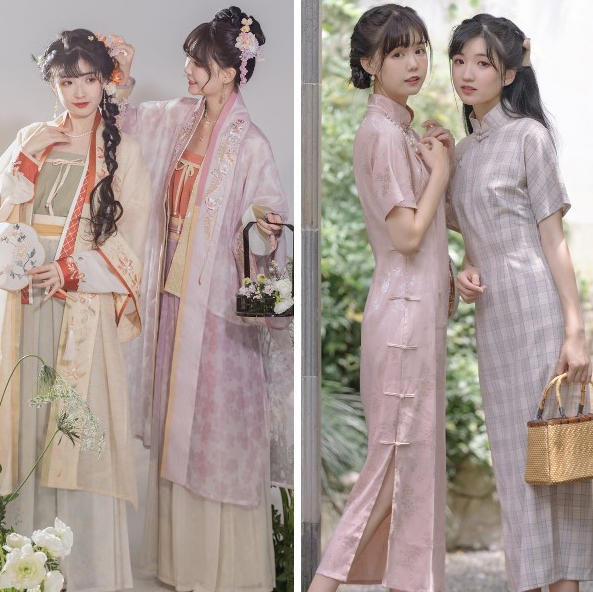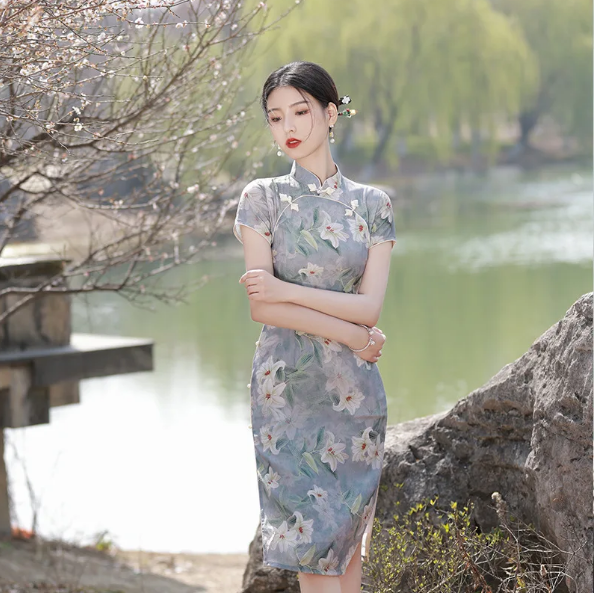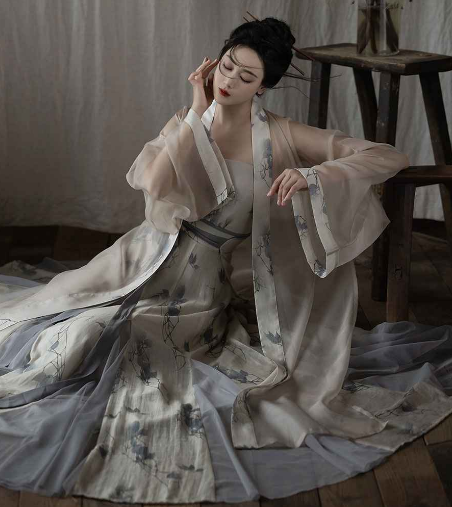Hanfu features loose, flowing robes with wide sleeves, while Cheongsam has a form-fitting silhouette with a high collar and slits.
Historical Origins
Hanfu: Ancient Chinese Clothing
Hanfu, a traditional garment of the Han Chinese, has its roots deep in China’s ancient past. Originating during the Han Dynasty, around 206 BC to 220 AD, it symbolizes a vital part of Chinese cultural heritage. This clothing style, known for its flowing robes and wide sleeves, reflects the aesthetics and values of traditional Chinese society. Craftsmen meticulously created Hanfu using silk, a material highly revered in ancient China, showcasing the nation’s skill in silk production. Over the centuries, Hanfu evolved, adopting various styles to represent different dynasties and social statuses. Its design, marked by cross-collared robes and a wrapping style, became a distinct icon of Chinese clothing traditions.
Hanfu often incorporated intricate patterns and embroidery, which depicted mythological creatures, nature, and symbols of good fortune. These garments were more than just clothing; they were artworks that exhibited the wearer’s social status and cultural identity.

Cheongsam: Evolution in the 20th Century
The Cheongsam, also known as Qipao, witnessed a significant transformation in the 20th century. This dress, initially a loose-fitting garment worn by Manchu women, adapted dramatically to the social and cultural changes of modern China. In the 1920s, in cosmopolitan Shanghai, the Cheongsam underwent a stylish reinvention. It became more form-fitting and elegant, reflecting the influence of Western fashion and the evolving roles of Chinese women in society.
Cheongsam designs typically feature high collars, slender cuts, and side slits, differing markedly from the traditional Hanfu. The fabric choices also expanded, incorporating not only silk but also other materials like cotton, wool, and later synthetic fabrics. The Cheongsam became a symbol of both traditional Chinese femininity and modernity, capturing the dynamic spirit of 20th-century China. Its popularity peaked in the mid-20th century, and it remains an iconic representation of Chinese fashion, often worn on formal occasions and celebrated in global fashion circles.
Cultural Significance
Hanfu: Symbol of Chinese Heritage
Hanfu stands as a proud symbol of Chinese heritage, embodying the country’s rich history and traditional values. It serves as a tangible connection to the ancient dynasties, offering a glimpse into the lifestyles and philosophies of early Chinese civilizations. In recent years, the Hanfu movement has gained momentum, with more people embracing these garments to celebrate and reconnect with their cultural roots. This resurgence reflects a growing interest in preserving and promoting traditional Chinese culture in a modern context.
Hanfu enthusiasts often wear these traditional garments during cultural festivals, weddings, and other ceremonial occasions. They view Hanfu as more than just clothing; it represents a lifestyle and a philosophy that honors the wisdom and customs of their ancestors. The garment’s designs, fabrics, and patterns are rich in symbolism, often conveying messages of harmony, balance, and respect for nature, core tenets of traditional Chinese thought.
Cheongsam: Representation of Modern China
Cheongsam, on the other hand, represents the dynamism of modern China. It mirrors the nation’s journey through the 20th century, capturing the essence of cultural adaptation and transformation. The sleek, body-hugging silhouette of the Cheongsam became a symbol of modern femininity and elegance in Chinese society, challenging traditional norms and embracing new ideals.
The popularity of the Cheongsam transcends national borders, becoming a global fashion icon. It showcases China’s ability to blend tradition with modernity, creating something unique and timeless. In contemporary China, the Cheongsam often appears at formal events, symbolizing both a respect for tradition and an embrace of modern, cosmopolitan values. Its enduring appeal lies in its simplicity, grace, and the way it encapsulates a period of significant societal change in China.
Design and Style Elements
Hanfu: Traditional Aesthetics and Silhouettes
Hanfu celebrates the elegance of traditional Chinese aesthetics through its unique design and silhouette. Characterized by its cross-collar, wide sleeves, and flowing robes, Hanfu offers a graceful and dignified appearance. The design often incorporates multiple layers, reflecting the depth and complexity of Chinese culture. These layers vary in length and volume, creating a dynamic and harmonious visual effect.
Hanfu also pays great attention to color symbolism, with colors chosen to represent various seasons, directions, and elements, rooted in Chinese cosmology. Embroidery featuring dragons, phoenixes, and floral patterns adds to its beauty, each motif carrying significant cultural meanings. The materials used, primarily silk, enhance the garment’s elegance, showcasing China’s historical expertise in silk production.
Cheongsam: Fusion of Eastern and Western Influences
Cheongsam exemplifies a fusion of Eastern and Western fashion elements. Its form-fitting style, evolved from traditional loose garments, marks a significant shift towards modernity. The high collars, slits on the sides, and the tapered waistline showcase a blend of traditional Chinese aesthetics with Western tailoring techniques. This blend creates a unique silhouette that is both elegant and functional, allowing for greater mobility while maintaining a sophisticated look.
The Cheongsam often features intricate embroidery, beadwork, or piping, adding luxurious details to the simple yet sleek design. The choice of fabrics ranges from silk and brocade to more modern materials like rayon and polyester, reflecting the evolving nature of Chinese fashion. The adaptability of the Cheongsam design to different fabrics and styles has helped it remain a relevant and cherished garment in contemporary fashion, both within China and globally.
Materials and Fabrication
Hanfu: Use of Silk and Brocade
Hanfu traditionally employs luxurious materials like silk and brocade, reflecting China’s rich textile heritage. Silk, renowned for its smooth texture and lustrous sheen, has been a hallmark of Chinese culture for millennia. Silk’s natural properties, such as breathability and its ability to adapt to temperature variations, make it ideal for the layered designs of Hanfu.
Brocade, another popular material for Hanfu, is a richly decorative woven fabric, often made with colored silks and sometimes with gold and silver threads. The art of brocade weaving, a craft perfected in ancient China, allows for intricate designs that are both visually stunning and culturally significant. These materials not only add to the garment’s aesthetic appeal but also signify the wearer’s status and elegance.

Cheongsam: Emphasis on Tailoring and Fit
The Cheongsam puts a significant emphasis on tailoring and fit, adapting to the contours of the body to create a sleek silhouette. This emphasis on fit marked a departure from traditional loose-fitting Chinese garments, reflecting the influence of Western fashion ideals. The precise cut and tailoring of the Cheongsam require a high level of craftsmanship, ensuring that the garment perfectly accentuates the body’s shape while allowing for ease of movement.
Cheongsam makers often use a variety of fabrics, including silk, cotton, and wool, and more modern materials like rayon and polyester. The choice of fabric often depends on the occasion and the desired effect. Silk remains a popular choice for formal Cheongsams due to its elegance and comfort, while other materials like cotton and polyester are used for more casual versions. The meticulous construction of the Cheongsam, with its fitted bodice and distinctive high collar, showcases the fusion of traditional Chinese sewing techniques with modern tailoring practices.
Occasions and Usage
Hanfu: Ceremonial and Festival Wear
Hanfu finds its primary use in ceremonial and festival wear, connecting wearers to China’s ancient traditions. During traditional festivals like the Chinese New Year, Mid-Autumn Festival, and the Dragon Boat Festival, Hanfu enthusiasts often don traditional attire as a celebration of their heritage. The garment’s elegance and historical significance make it a popular choice for weddings, tea ceremonies, and cultural performances as well.
Wearing Hanfu in these settings is not just about fashion; it’s a way to participate actively in the cultural rituals that have defined Chinese society for centuries. The garment’s design, reflecting the specific dynasty it represents, allows wearers to immerse themselves in the rich tapestry of Chinese history and cultural practices.
Cheongsam: From Daily Wear to High Fashion
The Cheongsam has transitioned from being everyday attire for Chinese women to a high-fashion statement on global runways. In the early to mid-20th century, the Cheongsam was a common sight in the streets of Shanghai and other Chinese cities, worn by women from various social strata. Today, while it has largely moved out of daily wear, the Cheongsam remains a popular choice for formal occasions, such as weddings, banquets, and important social gatherings.
In the realm of high fashion, the Cheongsam has inspired countless designers, leading to innovative interpretations that blend traditional motifs with contemporary styles. This evolution reflects the garment’s versatility and its ability to adapt to changing fashion trends while maintaining its distinct identity. The Cheongsam’s sleek silhouette and elegant lines continue to make it a symbol of sophistication and timeless style in the world of fashion.

Contemporary Revival and Adaptations
Hanfu: Movement for Cultural Renaissance
In recent years, there has been a remarkable revival of interest in Hanfu, driven by a grassroots movement for cultural renaissance. Enthusiasts and advocates of Hanfu aim to reconnect with China’s ancient traditions and promote its cultural heritage. This movement has gained significant momentum, with individuals of all ages embracing Hanfu as a way to express their pride in Chinese culture.
The revival of Hanfu has led to a surge in demand for skilled artisans who can create authentic garments. It has also created a market for modern adaptations of Hanfu, catering to different tastes and preferences. Hanfu is no longer confined to historical reenactments; it has found its way into everyday fashion, with people incorporating elements of Hanfu into their daily wardrobes. This resurgence serves as a testament to the enduring appeal and cultural significance of Hanfu in contemporary China.
Cheongsam: Modern Interpretations and Global Appeal
The Cheongsam has seen modern interpretations that have broadened its appeal both in China and globally. Fashion designers have embraced the Cheongsam’s timeless silhouette and incorporated it into diverse collections. These modern interpretations often blend traditional elements with contemporary fabrics and designs, appealing to a broader audience.
The global fascination with the Cheongsam has led to its adoption in various international settings, from red carpet events to high-end fashion shows. Its sleek lines and versatility make it a favorite among fashion enthusiasts who appreciate its elegance and cultural significance. The adaptability of the Cheongsam design allows it to continue evolving while preserving its core identity as a symbol of Chinese fashion and heritage.







